Info
Subfamily: Chloridoideae
Genus etymology: Chloris = Goddess of vegetation [Greek], generally used to refer to a pale green color
Species etymology: gayana = honorific for Claude Gay (1800–1873)
Photosynthetic type: C4 (warm season)
Nativity: naturalized - intentional
First recorded in Hawaiʻi: 1913
Map
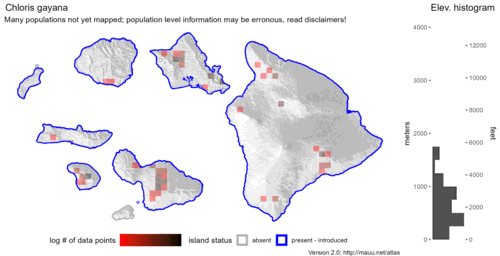

Inflorescence
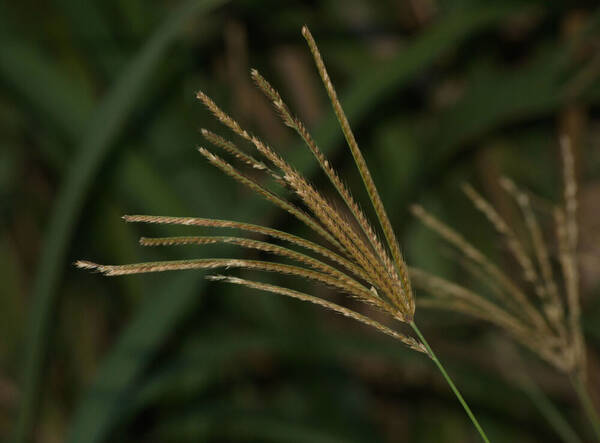
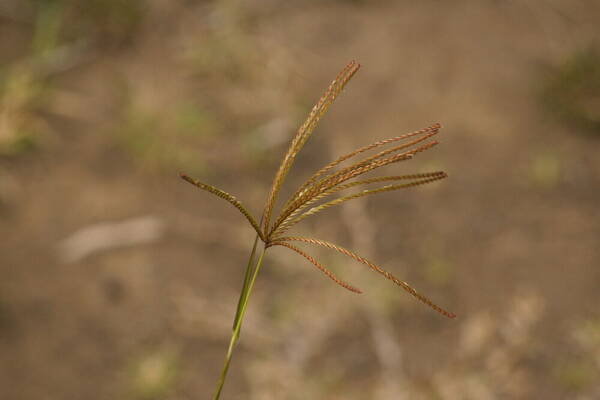
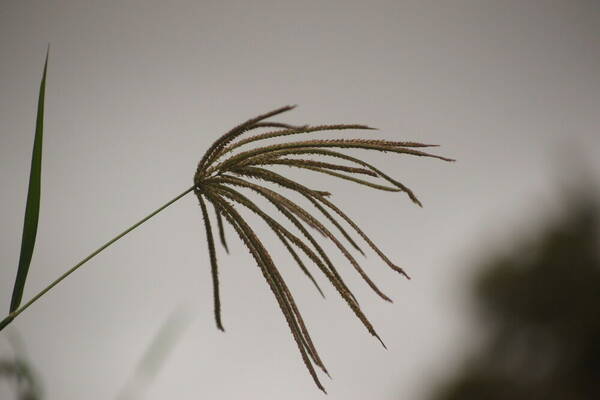
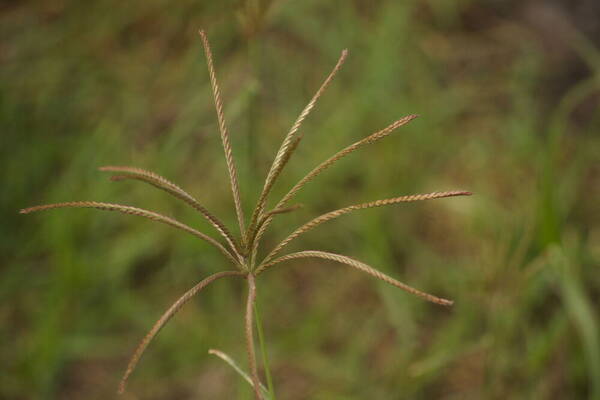
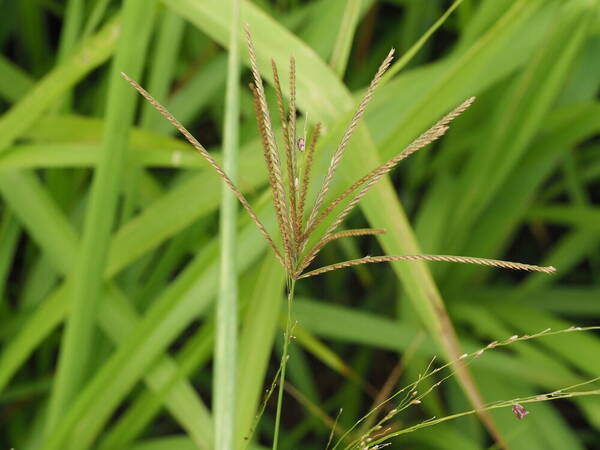
Plant


Habit

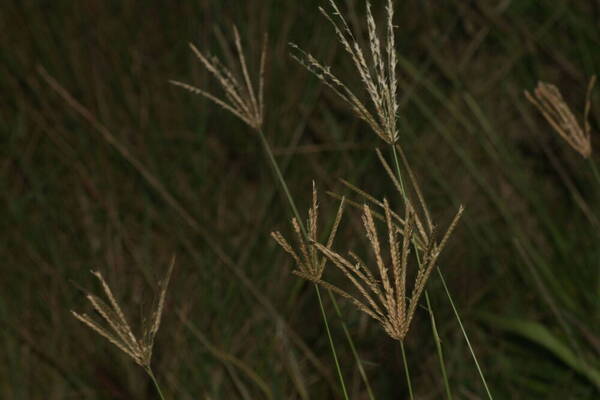
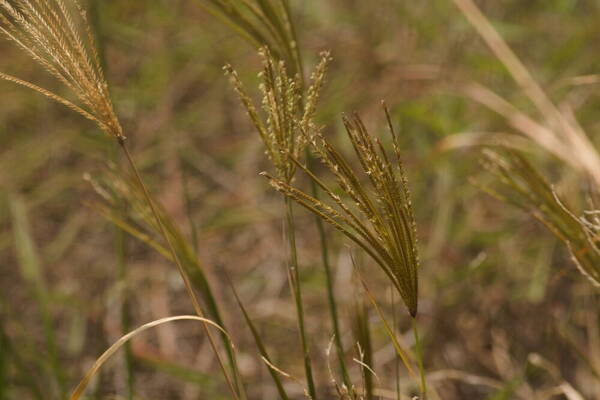
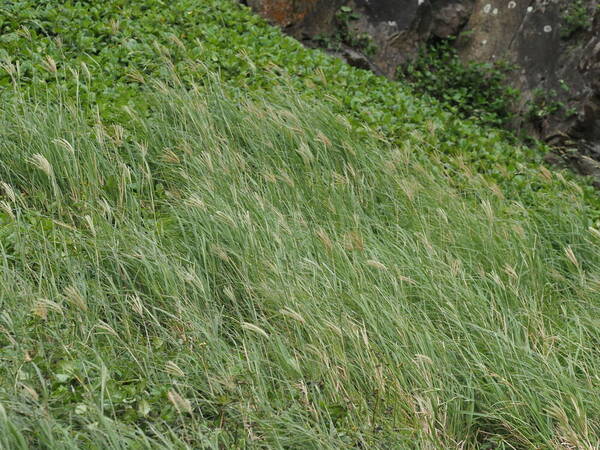
Spikelets
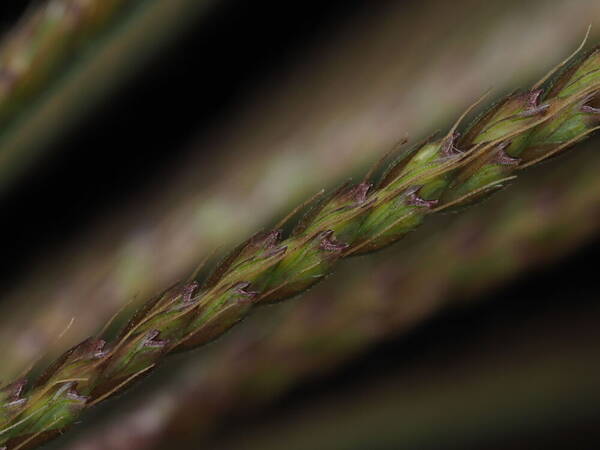
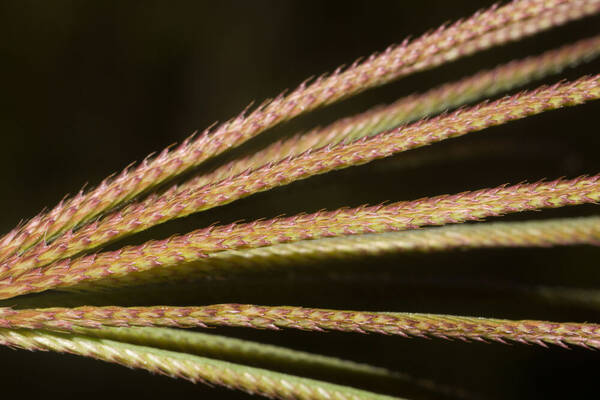
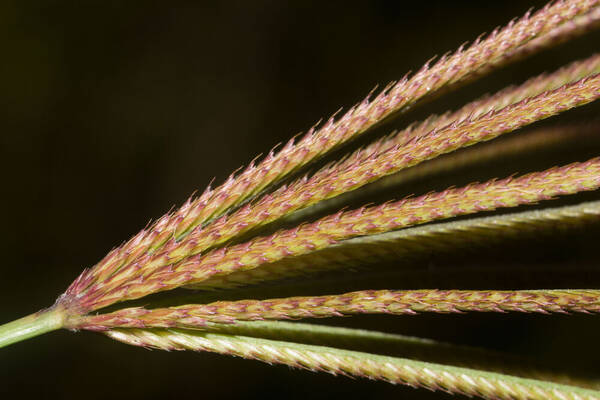
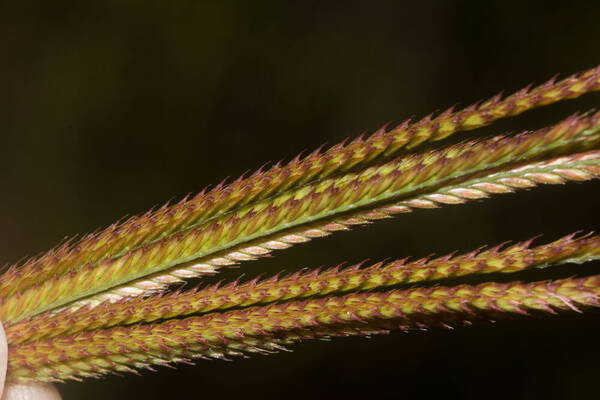
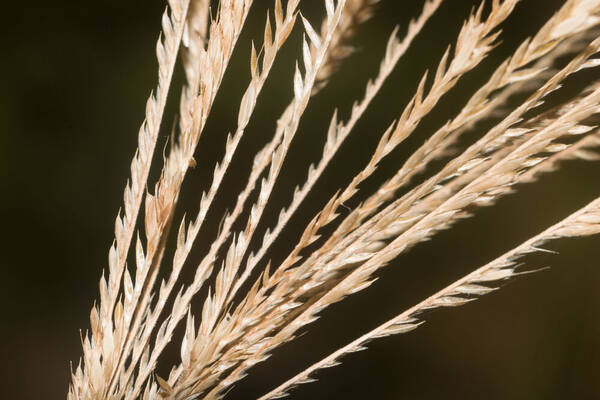
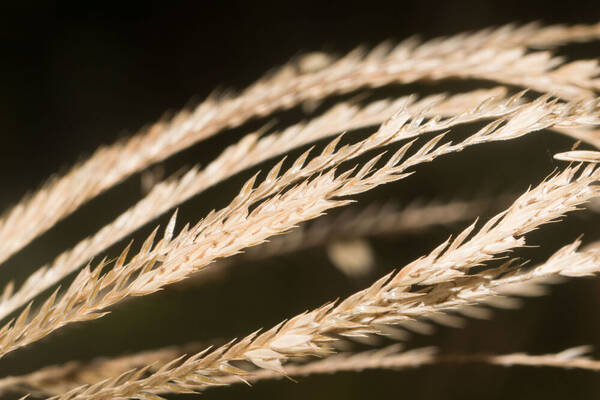
Collar
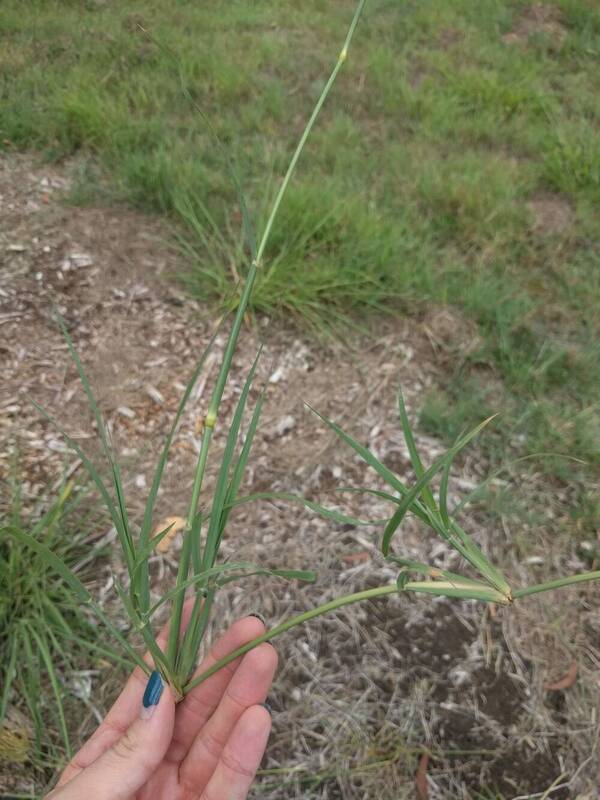
Description
Perennial; culms 0.5–2.2 m. high, stoloniferous, erect or ascending, occasionally rooting at the lower nodes. Leaf-blades flat, rarely involute, (15–)25–50 cm. long, (l.5–)3–9 mm. wide, tapering towards the apex. Inflorescence of (5–)7–20 digitate, ascending to spreading spikes 4–15 cm. long. Spikelets 3–4-flowered, 2-awned; lower glume 1 .5–2.5 mm. long; upper glume 2–4 mm. long including the awn-point; lowest lemma lanceolate in side view, 2.5–3.5 mm. long, pallid, sparsely to densely ciliate on the margins and keel, the awn 2–10 mm. long; callus rounded; 2nd lemma projecting from the side of the lowest lemma, lanceolate, 1.5–3 mm. long, ciliate on the margins, the awn 1.5–5.5 mm. long; 3rd lemma reduced to a scabrid clavate awnless scale 0.75–2 mm. long.
(Description source: Clayton, W.D. 1970. Flora of Tropical East Africa. Gramineae (Part 1). Crown Agents for Oversea Governments and Administrations, London. 176 pp. )
Stoloniferous perennial up to 1 m high; leaves linear, tapering. Inflorescence a head of 9–12 digitate racemes, these 3–12 cm long. Spikelets 3- to 4-flowered, 2-awned; fertile lemma lanceolate in profile, 2.9–3.2 mm long, sparsely to densely ciliate on the margins and keel, with an awn 4–5 mm long; 2nd floret with a palea and often a male flower, the lemma lanceolate, ciliate on the margins; 3rd lemma a scabrid oblong or clavate awnless scale; 4th lemma, if present, a glabrous clavate awnless scale.
(Description source: Cope, T.A, (1995) Flora Somalia, Vol 4. Royal Botanical Gardens, Kew, London. 312 pp. )
Stoloniferous perennial up to 150 cm tall, erect or geniculately ascending, sometimes rooting from the nodes; leaf laminas 5–30 cm × 1.3–6 mm, flat or rarely involute, tapering to a fine point.Inflorescence of 4–11 digitate racemes 7–10 cm long.Spikelets 3–4-flowered, 2-awned; inferior glume 1.6–2 mm long; superior glume 2.4–3.4 mm long; floret callus rounded; fertile lemma 2.6–3.6 mm long, lanceolate-ovate in profile, pallid, sparsely to densely ciliate on the margins and keel, the awn 3.4–7 mm long; 2nd lemma 1.5–3 mm long, lanceolate, rarely ciliate on the margins, the awn 1.5–5.5 mm long; 3rd lemma reduced to an awnless glabrous clavate scale 0.75–2 mm long, occasionally the 3rd lemma similar to the second, but then with a rudimentary 4th floret.
(Description source: Pope, G.V. (ed). 1999. Flora Zambesiaca. Volume 10. Part 2. Kew, London. 261 pp. )
Plants perennial; usually stoloniferous. Culms to 300 cm, erect. Sheaths glabrous or scabrous, often ciliate apically; ligules ciliate; blades to 30 cm long, 15 mm wide, scabrous. Panicles digitate, with 9-30 evidently distinct branches; branches 8-20 cm, usually somewhat divaricate, spikelet-bearing to the base, averaging 10 spikelets per cm. Spikelets strongly imbricate, tawny, with 1 bisexual and (1)2-4 usually staminate, sometimes sterile florets. Lower glumes 1.4-2.8 mm; upper glumes 2.2-3.5 mm; lowest lemmas 2.5-4.2 mm long, 0.7-1 mm wide, ovate to obovate or elliptic, somewhat gibbous, sides not grooved, pubescence variable, sides usually glabrous, sometimes scabrous or appressed pubescent, margins usually glabrous or appressed pubescent on the lower portions, sometimes throughout their length, sometimes with strongly divergent hairs distally, occasionally with strongly divergent hairs their entire length, divergent hairs, when present, 1+ mm, lemma apices inconspicuously bilobed, awned, awns 1.5-6.5 mm; second florets staminate or sterile, 2.2-3.2 mm long, 0.3-1 mm wide, similar to the first floret but more cylindrical, not widened distally, inflated, if at all, only near the apices, inconspicuously bilobed, awned, awns 0.8-3.2 mm; distal florets progressively smaller, longer than the subtending rachilla segment, awn-tipped or unawned. Caryopses 1-1.5 mm long, about 0.5 mm wide. 2n = 20, 30, 40.
(Description source: Barkworth, M.E., Capels, K.M., Long, S. & Piep, M.B. (eds.) 2003. Flora of North America, north of Mexico. Volume 25. Magnoliophyta: Commelinidae (in part): Poaceae, Part 2. Oxford University Press, New York. 783 pp. http://floranorthamerica.org/Chloris_gayana )
Glabrous perennials; culms erect or sometimes decumbent, usually with long, stout, flattened, leafy stolons, ocasionally rooting at lower nodes, 50-150(-200) cm tall. Lower sheaths about as long as internodes, upper sheaths somewhat shorter, striate, compressed, keeled; ligule membranous, ca. 0.5 mm long, ciliate; blades flat, rarely involute, 10-50 cm long, 3-5(-9) mm wide, usually keeled, upper surface near base sparsely papillose-hispid, apex attenuate. Inflorescences of (5-)7-20 digitate, ascending to spreading spikes 4-15 cm long, ascending when young, spreading or sometimes slightly reflexed when mature, rachis slender, scabrous, base tomentose; spikelets 3-4-flowered, pale yellowish brown, closely imbricate; glumes narrow, 1-nerved, the nerves scabrous, first glume ovate-elliptic, 1.5-2 mm long, apex obtuse or acute, second glume elliptic, 2.5-3.5 mm long, margins scarious, apex acute or bifid; first lemma broadly elliptic, irregularly rhomboid in profile, 3-3.5 mm long, ciliate and long-hispid toward apex, apex bifid, awn straight, 1-5 mm long, callus with a tuft of white hairs; palea 3-3.5 mm long, often exceeding lemma, submembranous, glabrous or sparsely scaberulous on upper part, apex bifid; rudiment of 2 sterile florets, lower one narrow, obtuse, 2-2.5 mm long, with a straight awn 1-2 mm long, upper one minute, truncate. Caryopsis ovoid, laterally compressed, ca. 1.5 mm long. [2n = 20, 30, 40.]
(Description source: O’Connor, P.J. 1990. Poaceae, pp. 1481–1604. In: Wagner W.L., Herbst D.R. & Sohmer S.H. (eds.)., Manual of the flowering plant of Hawaiʻi. Vol. 2. University of Hawaii Press & Bishop Museum Press, Honolulu )